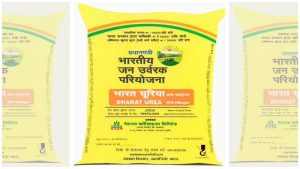26 Aug 2022 One Nation One Fertiliser scheme
General Studies Paper 3:Issues related to Direct and Indirect Farm Subsidies and Minimum Support Prices.
What is ‘One Nation One Fertiliser ‘ or Pradhan Mantri Bhartiya Janurvarak Pariyojna(PM-BJP) scheme?
- In this initiative, both public and private sector companies will be required to sell subsidized fertilisers under a single brand name, for example, BHARAT UREA or BHARAT DAP.
- The new brand name, along with a logo of the renamed scheme — Pradhan Mantri Bhartiya Janurvarak Pariyojna (Prime Minister’s Public Fertiliser Scheme) or PM-BJP — will cover two-thirds of the front of new fertiliser bags.
- The remaining space on the front will display information about the manufacturer, including name, logo, address and other statutory information.
- According to the Ministry of Chemicals and Fertilizers,the new fertiliser bags will be introduced.
- Fertiliser companies are advised not to procure any bags carrying the old design from 15 September onwards, the government has given them time till the end of this year to exhaust all old packaging into circulation beginning 2 October.

Government’s role in Fertilizer industry:
- There are some 26 fertilisers (inclusive of urea), on which the government bears subsidy and also effectively decides the Maximum retail price: MRPs of urea are currently fixed by the government, which compensates companies for the higher cost of manufacturing or imports incurred by them. The MRPs of non-urea fertilisers are decontrolled, but companies cannot avail of subsidy if they sell at MRPs higher than that informally indicated by the government.
- Through the Fertiliser (Movement) Control Order, 1973 the government with the help of the department of fertilizers not only decides subsidy and selling price of fertilizers but also at what price companies can sell. Department of fertilisers draws an agreed monthly supply plan on all subsidised fertilisers in consultation with manufacturers and importers. This supply plan is issued before the 25th of each month for the following month, with the department also regularly monitoring movement to ensure fertiliser availability as per requirement, including remote areas.
Rationale behind introducing this scheme: Since, the government is spending vast sums of money on fertiliser subsidy plus deciding where and at what price companies can sell. So , it has all the logic to introduce a single ‘Bharat’ brand for all subsidised fertilisers.
Drawbacks of the scheme:
- Any company’s strength ultimately is its brands and farmer trust built over decades. But,scheme has potential to disincentivise vise fertiliser companies from undertaking marketing and brand promotion activities.
- Fertliser companies may be reduced to contract manufacturers and importers for the government.
- Transfer of responsibilities from companies to government: Currently, in case of any bag or batch of fertilisers not meeting the required standards, the blame is put on the company. But now, that may be passed on fully to the government.


No Comments